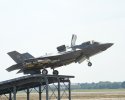The British military is facing a serious financial challenge, with an estimated £20 billion black hole to plug, and the inconclusive 8 June general election providing no way forward.
The ‘black hole’ in the Ministry of Defence’s (MoD) finances might, according to
, be as large as £20 billion (or around 5% of projected spending commitments) over the next ten years.
Meeting this challenge will require either a large uplift in cash from the Treasury or a significant reshaping of government aspirations.
If the latter route is chosen, then the MoD would need to look at deleting capabilities from the military, much like in 2010 when the maritime patrol aircraft programme was
, along with measures to reduce the size of the British Army, as well as other economy savings.
For example, previously and so-called ‘ring-fenced’ projects, such as the
, a
between the MoD and GCHQ, might now need to be raided for cash, and capabilities deleted or delayed. In this, and other capabilities, the temptation will be to take from areas that are classified and beyond the public gaze.
Yet such measures, even if radical in extent, will not be enough to deliver a long-term balanced budget; that will require more far-reaching decisions – something a full defence review might still deliver if one is announced. Several areas are worthy of greater consideration.
The UK has retained two independent formations for the purpose of theatre entry – that is, breaking into a conflict zone: by sea with
and the Royal Navy’s amphibious capability; and by land with
.
Given the overall size of the Armed Forces now, and the assumptions of major operations taking place solely as part of an alliance or a coalition, is it time to examine amalgamating these capabilities into a single Spearhead Brigade with this role?
Such a formation would transfer the Marines into the Army and allow the navy the flexibility to man one (and perhaps even both) aircraft carriers. The navy’s expensive amphibious capital ships could also be replaced with cheaper designs, following the example of the US Marine Corps and US Special Forces Command.
This would probably mean the purchase aircraft with greater airlift capabilities, such as a fleet of V-22 Osprey helicopters.
Along with such a move, decisions about the size of the UK
might be taken. Without the need to support two separate theatre entry formations, the new Lightning II force could be shrunk to become the dedicated aviation support to the new Spearhead force, manned by a Fleet Air Arm and supported by RAF infrastructure.
Uplifting Typhoon numbers could provide the RAF with sufficient mitigation (at a lower cost) to focus on delivering current operations while transitioning to an unmanned combat fleet over the next 30 years.
Such a mix would work well in demonstrating the UK’s role as a key US ally while building Britain’s industrial base in this area, as well as ensuring continued partnerships across Europe in aerospace.
The US might also be on the verge of taking such an approach: the US Marines will undoubtedly continue to transition to the F-35B, but it is possible that the carrier version of the Joint Strike Fighter, the F-35C, will never make it on to US Navy carriers.
The problems they have experienced with the F-35C might require a potential move from updated F-18s to a purely unmanned capability over the next generation.
The RAF could play a leading role by adopting such a position now: certainly, the Chief of the Air Staff, Air Chief Marshal Sir Stephen Hillier, is a visionary who could potentially deliver this position.
Such long-term changes will take time to bed in, but there remains a further choice facing the UK defence community, given the resource constraints it faces.
Broadly speaking, the Armed Forces are made up of two forces: a high-readiness group conducting operations now, or preparing to deploy in the near future; and a lower-readiness group that is preparing for war only at extended notice.
The former is a much smaller part of the Armed Forces and runs at a very high tempo, shifting between countless operations as political priorities change.
The latter makes up the greater part of the uniformed body, and is a vital part of the wider deterrence posture of the UK. It also provides resilience to civilian emergency services and costs much more in total than the high readiness force.
In purely financial terms, there is an argument for shifting the balance of priorities and investment between these two forces towards the former, accepting that in doing so, one could weaken the overall defence posture of the UK.
Such choices would reshape the UK’s defence capabilities over several generations, but the scale of such changes should not be underestimated. They would also go some way to balancing the MoD’s books.
However, such decisions should not be miscommunicated as improved capabilities for the forces. These choices cut capability and would harm the already fragile morale of uniformed and civilian staff. They would also undermine the Armed Forces’ ability to protect and defend the country in the long term.
But if balancing the defence budget is the primary requirement, these are the types of choices that must now be taken.








